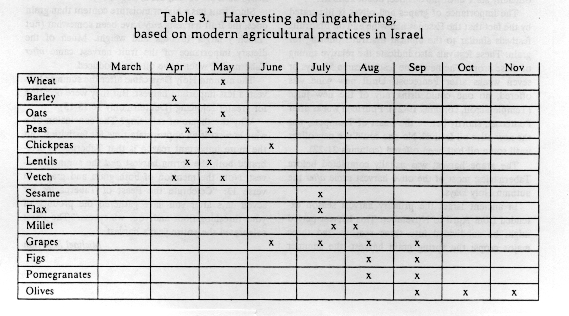Old Testament Laws: Harvest Seasons of Ancient Israel
Various biblical laws and stories refer to ancient Israelite crops and harvests. It may therefore be helpful to have some general information about the harvests and their seasons. Major crops of the land are listed in Deuteronomy 8:8: wheat, barley, grapes, figs, pomegranates, olives and honey.
The spring harvest
Various herbs and legumes were harvested in spring, but the most important spring crops were cereals: barley and wheat. A spring ritual took particular note of the cereals: Newly harvested grain could not be eaten until the firstfruits of grain had been offered on the “day after the sabbath” of the Festival of Unleavened Bread (Leviticus 23:9-14). Pentecost, near the end of the grain harvest, included grain and loaf offerings (verses 16-17). Pentecost was also called “the Feast of Harvest” (Exodus 23:16).
Barley and wheat were planted in the autumn and ripened in spring. Barley matured faster and would be harvested sooner. The firstfruits of grain offered during the Festival of Unleavened Bread would have been barley. “In the early stages of the Israelite settlement the most important cereal was barley…because of the necessity to settle fringe areas and barley’s tolerance of harsh conditions” (Oded Borowski, Agriculture in Iron Age Israel, 1987, page 7).
“The amount and distribution of rainfall together with soil conditions limit the area in Eretz-Israel where wheat is cultivated to the coastal valleys, the Valley of Jezreel, the Upper Jordan Valley, and the Beth-shan Valley. [The Israelites did not conquer these areas at first (Judges 1:19).] In the northern Negev, wheat does well only in rainy years, which are not frequent” (page 89).
“Wheat ripens later than barley and, according to the Gezer Manual, was harvested during the sixth agricultural season, yrh qsr wkl (end of April to end of May)” (page 88; also see the chart on page 37 of Borowski’s book, reproduced below).
“Where the climate is warmer, as in the Shephelah and the Jordan Valley, crops mature earlier than in regions where the climate is cool, as in the Judean hill-country and the Galilee” (page 57). In Galilee, for example, part of the grain harvest would be completed after Pentecost, especially in years in which Pentecost came as early as mid-May. Even though all the crop might not be harvested by Pentecost, Pentecost celebrated the entire grain harvest, including the small amount of grain to be harvested shortly after the festival.

The summer harvest
After Pentecost, most of the harvest was fruit: grapes, olives, dates, figs, pomegranates and numerous fruits, seeds and vegetables of lesser importance.
Deuteronomy 11:10-11 contrasts Egypt’s irrigated vegetable gardens with Canaan’s hilly terrain and seasonal rains, implying that vegetables were less common in Canaan. Proverbs 15:17 indicates that vegetables were among the least-esteemed foods. The Bible has few references to gardens, cultivated vegetables and wild plants. “The small number of references to vegetables and the low regard in which vegetables were held suggest very strongly that vegetables…did not constitute an important part of the Iron Age diet in Eretz-Israel” (page 139).
Now let’s look at the major crops after Pentecost. Grapes were the first major crop to ripen: “In a good year, when the [grain] yield was great, threshing and grape picking overlapped” (page 62). That would be in June, technically in spring, since summer doesn’t officially start until the solstice, June 22.
The importance of grapes and olives is illustrated by the fact that the Essenes had wine and oil firstfruits festivals similar to the biblical firstfruits offering for grain. These festivals also indicate the relative timing of these crops. The new wine festival came 50 days or seven weeks after Pentecost. Until new wine was offered, no one could drink any of the new juice (Temple Scroll, columns 19-21). Fourteen weeks after Pentecost, shortly before the Feast of Trumpets, was the new olive oil festival. No one could use new olives until some oil had been offered (columns 21-22).
The grape harvest was usually completed before Tabernacles, but most of the olive harvest came after the autumn festivals. In ancient Israel the primary harvest season extended from April to November. This harvest period might be subdivided into three seasons and three major crops: the spring grain harvest, the summer grape harvest and the autumn olive harvest. These harvests have a general correspondence with the festivals. Some grain might be harvested after Pentecost, threshing and grape-picking might overlap, and the olive harvest came both before and after the Festival of Tabernacles.
Relative importance
Which harvest was larger and more important? In terms of dietary calories, the spring grain harvest was most important. Borowski calls barley and wheat “the main food staple of the ancient Israelite” (page 57). E.P. Sanders offers a more detailed estimate: “Grain constituted over fifty percent of the average person’s total caloric intake, followed by legumes (e.g. lentils), olive oil, and fruit, especially dried figs” (Judaism: Practice and Belief, 63 BCE-66 CE, 1992, page 129).
Since fruit has a higher moisture content than grain does, the fruit harvests may have been larger in bulk and weight. Most of the dietary importance of the fruit harvest came after Tabernacles, when olive oil was produced.
The autumn festivals came after the summer harvest, a less-important harvest. But the fall festivals were associated with greater rejoicing (Deuteronomy 16:13-15). Why the theme of rejoicing? The conclusion of a wine harvest is an appropriate time for festivities. But another reason may be that Tabernacles celebrated both the spring harvest and the summer harvest. Note the mention of both grain and grapes in verse 13: “Celebrate the Feast of Tabernacles for seven days after you have gathered the produce of your threshing floor and your winepress.”
Author: Michael Morrison
